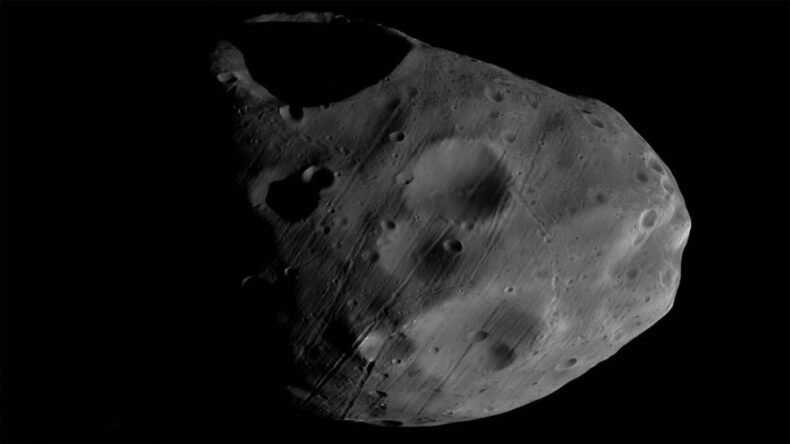The Mars Express probe, operated by the European Space Agency (ESA), has received a software update that enables it to observe the enigmatic Phobos in considerably more detail than ever before after nearly twenty years of operation.
Role of MARSIS
The MARSIS, or Mars Advanced Radar for Subsurface and Ionosphere Sounding, instrument was created to investigate Mars’s surface, but during a recent flyby, it was able to collect detailed information on one of Mars’s two moons.

This summer, MARSIS’s software was upgraded from its Windows 98 foundation, enabling it to gather and analyse data more effectively. This enabled it to get a close-up view at Phobos.
ESA’s Simon Wood, who handled the upload of the new software, stated in a statement, “We didn’t know if this was possible. The final, successful software modifications were uploaded to the spacecraft just hours before the flyby. The crew tested several different iterations of the program.”
What is Phobos
The largest of the two Martian moons, Phobos, is about 28 kilometers wide at its widest point. It makes three daily revolutions of Mars, passing so close to the planet’s surface that from some parts of Mars, it cannot be seen.
Every hundred years, this moon approaches Mars by 1.8 meters. This indicates that it will either collide with Mars in 50 million years or disintegrate into a ring, according to NASA.

Stickney, a 9.8-kilometer-wide impact crater, is the asteroid’s most noticeable feature. Phobos was gouged and virtually broken by the impact that formed Stickney, and as can be shown from measurements taken by the Mars Global Surveyor, it has also been subjected to hundreds of other meteorite impacts. Some of these hits resulted in landslides that left tracks that served as markers for the crater slopes.
Data Collected by Mars Express
On September 23, Mars Express conducted a flyby of Phobos, passing the moon at a distance of about 50 miles. Since the MARSIS equipment often travels more than 150 miles from Mars, it was built to function at considerably greater distances.
The greatest place to seek for its source is inside Phobos. Standard optical images can only reveal so much to scientists. Instruments that can probe into Phobos, on the other hand, can disclose a lot. MARSIS can help in this situation.

MARSIS data from Phobos flyby. The top-right image shows the ‘radargram’ acquired by MARSIS during the flyby of Phobos on 23 September 2022. A radargram reveals the ‘echoes’ created when the radio signal emitted by MARSIS bounces off something and returns to the instrument. The brighter the signal, the more powerful the echo. The continuous bright line shows the echo from the moon’s surface. The lower reflections are either ‘clutter’ caused by features on the moon’s surface, or, more interestingly, signs of possible structural features below the surface (e). Section A—C was recorded using an older configuration of the MARSIS software. The new configuration was prepared during the ‘technical gap’ and successfully used for the very first time from D—F. The left and bottom-right images show the path of the observation across the surface of Phobos.
A significant software update allowed MARSIS to collect data during the latest near approach. Now that it has the ability to “see,” it can fly by this little moon and look for structural hints beneath its surface.
The Italian National Institute for Astrophysics’ MARSIS team member Andrea Cicchetti commented, “During this flyby, we used MARSIS to analyze Phobos from as near as 83 km.”
“As we come closer, we may analyze its structure in greater detail and discover important features that are undetectable from a further distance. We are convinced that in the future we could use MARSIS at distances closer than 40 km. During a few flybys between 2024 and 2025, Mars Express’ orbit has been adjusted to bring us as near to Phobos as possible, providing us with excellent possibilities to try. MARSIS from closer than 40 km. During a few flybys between 2024 and 2025, Mars Express’ orbit has been adjusted to bring us as near to Phobos as possible, providing us with excellent possibilities to try.”
The Next Martian Mission
The next Martian Moons eXploration (MMX) mission will land on Phobos and bring back a sample of its surface materials to Earth. ESA and its Member States will be taking part.
The Japanese Space Agency (JAXA) is in charge of the MMX mission, which is slated to launch in 2024 and return its samples to Earth in 2029. In order to thoroughly explore Phobos in order to get ready for the MMX mission, instruments on board Mars Express were essential.
Also Read: Life on Mars! Conked due to Climate change













